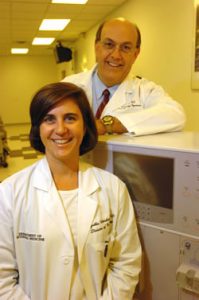ECU dialysis technology earns a top spot in business plan competition
A business plan for a kidney dialysis technology devised at East Carolina University was one of two winners at the 12th annual $10K Business Plan Competition managed by the Entrepreneurship Education Initiative at the North Carolina State University College of Management.
The technology, designed to help reduce the number of hours people with end-stage renal disease spend in dialysis, was developed by a team led by Dr. Paul Bolin, associate professor of internal medicine and chief of the nephrology division at the Brody School of Medicine at ECU. Working with Bolin on the technology was Dr. Craig J. McCotter, now chief cardiology fellow at the University of Virginia and a former ECU medical student, and Dr. Cindy Christiano, a clinical assistant professor of medicine at ECU.

A business plan for a kidney dialysis technology devised by Drs. Cindy Christiano and Paul Bolin, pictured, of the Brody School of Medicine at East Carolina University, along with Dr. Craig McCotter, received a top award at a recent competition.
N.C. State students Matt Hallam, David Hodl, Eric Hulsey and Nocha van Thielen developed the business plan for Pulse Filtration Technologies, a company that would bring the technology to market. They assessed a variety of ideas before settling on the ECU dialysis concept, made available to the students through the ECU Office of Technology Transfer. All four medical schools in the state submitted biotechnology product ideas for the competition, according to Bolin.
“The dialysis technology from ECU was consistently at the top of our rating criteria, and we chose to build a business plan around it,” Hodl said.
Their plan netted them a $6,000 prize. Hodl said team members haven’t decided what they’ll do with the money or what’s next for the proposed firm. “The company is in its infancy,” Hodl said. “The team is taking time to assess how best to proceed, but the potential for a company is there.”
A kidney dialysis machine mimics some of the functions of a human kidney. One of the primary jobs of a human kidney is to remove urea and certain salts from the blood so they can exit the body in urine. In a dialysis machine, blood from the patient runs through tubes made of a semi-porous membrane. Outside the tubes is a sterile solution made up of water, salts and other components. Red and white blood cells and other important blood components are too large to fit through the pores in the membranes, but urea and salts flow through membranes into the sterile solution, or dialysate, and are removed.
Traditionally, the flow of the blood and dialysate has been smooth and steady. “We thought if it flowed constantly, it was a good thing,” Bolin said. But that constant flow results in uneven urea removal, he added.
McCotter, at the time a medical student with an engineering undergraduate degree from N.C. State, theorized that a heart-lung machine, used to bypass a stopped heart during coronary bypass surgery, might get oxygen to the brain better in adult patients if it delivered blood in a pulsing manner similar to the natural heartbeat. McCotter told Bolin about his idea, and Bolin realized the idea could work for dialysis, too.
Bolin’s group built prototypes using a pediatric coronary bypass pump that has an adjustable pulse. They tested it on a laboratory animal and found it was up to 35 percent more efficient than a normal dialysis pump. The benefit works two ways: dialysis patients who typically reach their target level of urea and salt removal during dialysis could reach that target in one-third less time, and patients who have a hard time reaching their target at all could come one-third closer to reaching it.
ECU’s technology transfer office chose to patent the concept of the device rather than an actual device to allow design flexibility and to prevent a competitor from designing a machine that uses the same idea but is different enough to avoid patent fees, Bolin said. Putting the technology into action could be a simple as designing a new circuit board for existing dialysis machines and installing it.